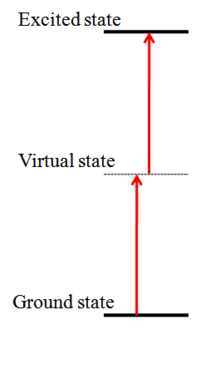
In atomic physics, two-photon absorption (TPA or 2PA), also called two-photon excitation or non-linear absorption, is the simultaneous absorption of two photons of identical or different frequencies in order to excite an atom or a molecule from one state (usually the ground state), via a virtual energy level, to a higher energy, most commonly an excited electronic state. Absorption of two photons with different frequencies is called non-degenerate two-photon absorption. Since TPA depends on the simultaneous absorption of two photons, the probability of TPA is proportional to the photon dose (D), which is proportional to the square of the light intensity (D ∝ I2); thus it is a nonlinear optical process.[1] The energy difference between the involved lower and upper states of the molecule is equal or smaller than the sum of the photon energies of the two photons absorbed. Two-photon absorption is a third-order process, with absorption cross section typically several orders of magnitude smaller than one-photon absorption cross section.
Two-photon excitation of a fluorophore (a fluorescent molecule) leads to two-photon-excited fluorescence where the excited state produced by TPA decays by spontaneous emission of a photon to a lower energy state.
- ^ Tkachenko, Nikolai V. (2006). "Appendix C. Two photon absorption". Optical Spectroscopy: Methods and Instrumentations. Elsevier. p. 293. ISBN 978-0-08-046172-4.